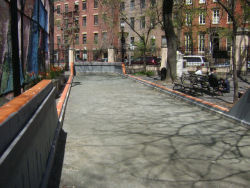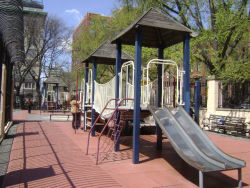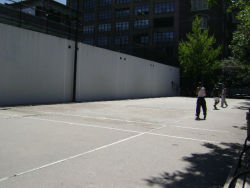James J Walker Park
James J. Walker
James J. Walker (1881-1946) was a New York politician whose style and exploits made his name synonymous with the Jazz Age. Born on June 19, 1881, Walker attended St. Joseph’s Parochial School, St. Francis Xavier, and New York Law School. Instead of preparing for the bar on completion of his law classes in 1905, Walker tried his hand at song-writing. His biggest hit —"Will You Love Me in December as You Do in MayΑ"—sold well, but his entertainment career soon came to an end. Billed as the "Young Man’s Candidate," Walker was elected Assemblyman to Manhattan’s Fifth District in 1910. The young politician both passed the bar and married Janet Allen in 1912.
In 1914 Walker was elected to the State Senate with the endorsement of Tammany Hall. As Senator, he lobbied successfully for the legalization of Sunday baseball and professional boxing, while continuing to work as a lawyer. Jimmy Walker—also known as "Beau James"—socialized with stars of the Broadway stage and the sports world and became known for his stylish dress. In 1925 he ran a victorious campaign for mayor, again with the endorsement of Tammany Hall. During his first term, he founded the Department of Hospitals, preserved the nickel subway fare, and rooted out corruption in the Police Department and Department of Health.
Shortly after Walker won a second term in 1929, an investigation led by Samuel Seabury was launched to determine if he had accepted bribes for municipal contracts; his relationship with the actress Betty Compton also caused a sensation. Resigning in 1932, after formal charges of corruption had been filed, Walker left for Europe, divorcing his wife and marrying Compton. Returning to New York in 1935, the couple adopted two children; they divorced six years later. In 1940 Mayor Fiorello D. LaGuardia appointed Walker labor arbitrator for the garment industry, and Jimmy became a popular speaker at banquets and rallies. James J. Walker died on November 18, 1946.
Bordered by Hudson Street, Clarkson Street, St. Luke’s Place, and the Carmine Street Recreation Center, James J. Walker Park has a colorful history to match the vivid life of its namesake. From 1812 to 1895, the land served as St. John’s Cemetery, the burial ground of Trinity Church. Parks acquired the land in 1895. Originally called St. John’s Park, the name changed to Hudson Park by 1896, for the bordering street to the west. Architects Carrere and Hastings provided an elegant park design, which included a sunken garden, lagoon, perimeter walk, and gazebo. In order to provide space for active recreation, a new playground open in 1903. A large, rectangular marble sarcophagus on the north side of the park, dedicated in 1834 to three fallen firemen, serves as the only reminder of the land’s former role as a cemetery.
Over the course of the past century, the park has evolved to serve the needs of its community. By 1935 a public restroom stood on the east end, a larger playground was sited atop the now-filled lagoon, and a baseball field dominated the west side. In 1946 the park was paved and a sandlot baseball diamond was built. In 1947 the City Council changed the name of the park to honor "Beau James," whose family had moved to 6 St. Luke’s Place in 1886. The renovation of the playground in 1972 included the installation of slides, teeter-totters, benches, tire swings, a pipe tunnel, sand boxes, an arch climber, and a geodesic dome.
Spurred by community efforts, including ninety letters written by neighborhood children to the Mayor’s office, a $250,000 capital renovation project began on June 24, 1996. The installation of play equipment, a spray shower, benches, trees, an iron fence, and safety surfacing have made the park a mecca for neighborhood families. Animal art includes handmade tiles salvaged from the 1972 renovation and horse-head hitching posts. As a fitting tribute to the man who legalized Sunday baseball, the ballfield continues to draw athletes of all ages.
Check out your park's Vital Signs
Clean & Safe
Green & Resilient
Empowered & Engaged Users
Share your feedback or learn more about how this park is part of a
Vital Park System







